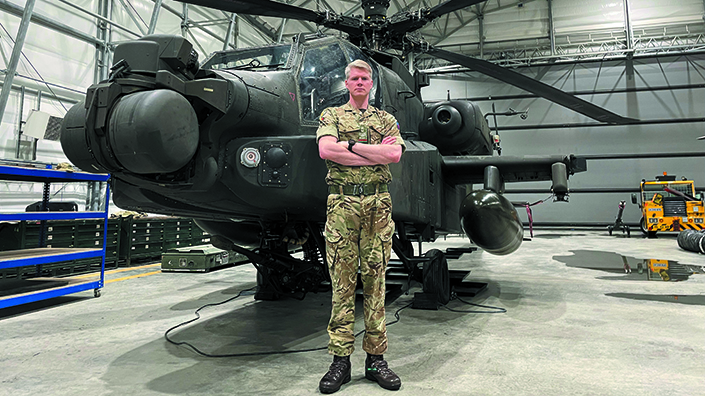When the dust settled over Camp Bastion that evening in 2011, Armfield and the rest of the engineers got to work. They had to rip out and replace the engines on four Apaches. That’s eight engines in the time it takes the earth to spin once. Back at their base in Wattisham, Suffolk, they’d set aside a week to do one.
For the next 36 hours, 60 people swarmed around the Apaches. They assigned roles and formed work lines. Each soldier had a part to play. There was coffee and adrenalin. The clock ticked.
“It takes you,” Sean remembers. “You get a few finished and you get a second wind. Then a third. You realise you can get it done. And when you see the people come back (after being evacuated) you know you’ve helped save lives.”
Over a decade later, Sean is still at war with the elements. This time, he’s 200 miles inside the Arctic Circle, at Bardufoss in Norway. There’s no sand. Now it’s snow. And temperatures that plunge to -30°C.
The British Army’s 4 Regiment Army Air Corps is back training pilots, engineers and support crews to fly Apaches in the extreme cold. They call the Arctic the “true test” for one of the army’s most sophisticated aircraft, armed with Hellfire missiles and stacked with the latest technology.
White clouds
“If you can operate here, you can operate anywhere,” the saying goes.
Sean’s done four tours to Afghanistan now. He’s served in the Middle East, in the US and on board the navy’s aircraft carrier HMS Prince of Wales (where salt, rust and remoteness offer their own, unique engineering challenges).
In the Arctic, soldiers battle sub-zero temperatures, fluids become solids and condensation turns to ice. Landing in snow throws up white clouds, so soldiers must land blind, using their instruments. In a jungle or a desert, a soldier can sit on their backpack for an hour and think. In the Arctic, they don’t have that luxury.
Sean has moved into management now, so his job is to make sure that the dozens of engineers he works with are trained and keep the Apaches flying safely.
Family background
Sean comes from a family of engineers. His earliest memories are of his father tinkering with nuts, bolts and brackets. His dad helped build the famous billboard in Piccadilly Circus (which earned his company a mention in newspapers) and is now working on the Big Ben restoration.
When Sean was young, his father arranged for a motorcycle shop to hire his son for a few hours a week. The £20 or so Sean earned came, secretly, from his dad’s pocket. Sean’s two brothers are also in the trade.
The army proved a magnet for Sean because it brought together his passions for engineering and testing his endurance. There was a physical dimension to being a soldier. And, of course, the adventure.

Staff sergeant Sean Armfield
At heart, Sean is a mechanical engineer. He started out as an aircraft technician but as he climbs the ranks he’s learning more about other trades, such as avionics. He’s a proud member of the IMechE, working on getting his next qualification. In his future, he sees more leadership responsibilities and, perhaps, getting more involved in investigations.
“You’re learning constantly,” he says of being a soldier engineer. “There’s a fixed career path, which is reassuring. But every time you open a curtain, you see the next layer of engineering.”
And, always, there’s the magic of watching an aircraft take off.
There’s a lot more desk work now, and less ripping out engines, but Sean is still testing his body’s endurance. He’s done an Ironman triathlon and is training for his next one. He’s got plans to cycle more than 300km through Spain. And he’s a Nordic ski instructor, who teaches cross-country skiing (the kind where you ski up, not down hills).
Like father, like son
Sean’s a father now too. His son is too young to work at a motorcycle shop. He’s one year old. But last Christmas, Sean bought some plywood and built his boy a giant play board, loaded with locks, levers, zips and bells.
“If there’s a switch, he’ll press it. If there’s a chain, he’ll pull it,” Sean says. “Maybe he’s of that mind as well.”
Want the best engineering stories delivered straight to your inbox? The Professional Engineering newsletter gives you vital updates on the most cutting-edge engineering and exciting new job opportunities. To sign up, click here.
Content published by Professional Engineering does not necessarily represent the views of the Institution of Mechanical Engineers.